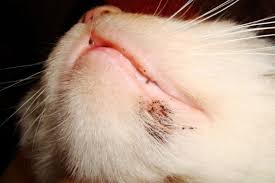During the flea life cycle the flea goes through four stages of growth which are;
- Egg stage
- Larvae stage
- Pupae stage
- Adult stage
This is complete metamorphosis, and the length of each stage largely depends on the temperature and humidity of its environment. It can range from two days to three months.

EGGS
Female fleas need a blood meal before they are able to lay their eggs. They lay at least four eggs after each feeding usually close to the end of the female’s lifespan. It takes approximately ten days for the eggs to hatch. During this stage in the flea life cycle since they do not stick together, they fall freely to the floor and hatch into larvae.
LARVAE
When the egg hatches to larvae during the flea life cycle, it quickly crawls away into shaded locations like underneath furniture, pet beddings, rugs and floorboard cracks. Their development depends on how favorable their environment is, if it is a good one, they can grow to five millimeters, although eyes and legs are absent, they get around by crawling. Their worm-like bodies become darker with time as they continue to feed on the feces of the fully developed adult, dead skin cells, dead insect feathers and other organic matter. At this stage they do not feed on fresh blood.
However, they will die off in an environment with a relative humidity of 40% because they do not thrive in a dry environment. It is completed within four to eighteen days.
PUPAE STAGE
The larvae flea life cycle stage elapses once it has successfully built a cocoon to serve as a protection for the pupae and adult stages. This can last as long as one year or until conditions are good enough for the adult to emerge.
ADULT STAGE
The adult flea emerges once there is an increase in carbon dioxide around its surrounding indicating the presence of a host. This is because they need fresh blood immediately, they break out from their protective cocoon.
FLEA SIGHTINGS
At the egg stage of the flea life cycle, they are difficult to spot due to the fact that they are very tiny. Since larvae and pupae are virtually inactive people cannot see them, they are most likely to identify only the adults due to their feeding habit and other activities.
Adults require food immediately when they emerge, so homeowners spot them easily after they come back home and are attacked by new, hungry fleas. Fleas can also be seen clearly on the bodies of infested pets; some drop off when they are being groomed. The parasites can be seen floating around on their bathwater.
INDICATIONS OF FLEA BITES ON PETS AND HUMANS
- Animals begin to itch and scratch excessively.
- Flea bites leave the skin red and swollen.
- Adult flea droppings on the pet’s fur.
- Hair of infested pets falling out.
- Adult fleas spotted on pet and human sleeping areas or on the rugs.
PROPERTY OWNERS CONCERNS ABOUT FLEAS
People are usually worried about the constant skin irritation, their health because flea bites can transmit diseases even to pets. If there is a flea infestation around the house always and the pets are clean of fleas then it is time to exterminate rodents as they serve as hosts also.
These are some diseases that can be transmitted through flea bites;
- Murine typhus
- Bartonellosis
- Flea tapeworm
- Secondary bacterial infection
Pets suffer from the following animal diseases transmitted through flea bites;
- Dipetalonemareconditum
- Acanthocheilonemalreconditum
- Typhus
- Flea tapeworm
- Rickettsia felis
- Bartonellosis